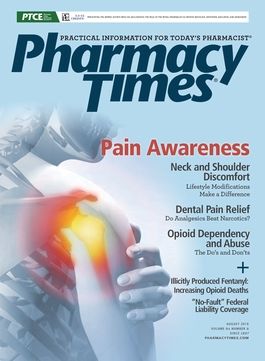Publication
Article
Pharmacy Times
Neck and Shoulder Pain: Causes, Management, and Prevention Strategies
Author(s):
Neck and shoulder pain can result in significant discomfort for patients, which affects their quality of life, can decrease work productivity, and increase outpatient visits and the emotional and financial burden on patients.1 Although the causes of both conditions may differ, treatment options are generally similar. Neck pain symptoms include difficulty moving the head, headaches, muscle spasms and tightness, and pain that worsens when holding the head in place for long periods, such as when driving or working on a computer.2 Shoulder pain can develop from the shoulder joint or any of the surrounding ligaments, muscles, or tendons.2 Pharmacists can play an important role in managing patients with neck and shoulder pain and providing prevention counseling tips.
CAUSES
The neck can be susceptible to conditions and injuries that may cause pain and restrict motion. Similarly, the shoulder is prone to injury because it is a mobile joint with a large range of movement. Neck and shoulder pain can have a variety of causes (see table).

MANAGEMENT
Neck pain
Mild to moderate neck pain usually resolves within 2 to 3 weeks with OTC therapies. Patients should seek medical care when neck pain is continuous and persistent, severe, accompanied by pain radiating down the arms or legs, or includes headaches, numbness, tingling, or weakness. Acetaminophen and nonsteroidal anti-inflammatory drugs (NSAIDs) can be used as OTC neck pain management medications.3,5 Ice or moist heat can also be applied to the neck. Pharmacists should tell patients that non-aspirin NSAIDs, such as ibuprofen, can increase the risk of serious cardiovascular adverse events and should therefore be used at the lowest possible dose for the shortest duration of therapy.6 Patients using acetaminophen should not exceed the maximum daily dose of 4000 mg/day. Remind individuals not to use OTC acetaminophen products if they are taking prescription medications that also contain acetaminophen as the active ingredient. Educate patients to read the drug facts label on OTC medications care- fully, especially combination products, as these may contain acetaminophen.
Physical therapy can offer neck-strengthening exercises to help ease pain and prevent recurrence.3,5Transcutaneous electrical nerve stimulation (TENS) involves placing electrodes on the skin near painful areas to deliver tiny electrical impulses that may decrease pain.5 Traction is another treatment method that involves using an air bladder, pulleys, or weights to gently stretch the neck, which may help relieve pain.3 Steroid injections should be reserved for pain not resolved by other methods, such as OTC products or physical therapy.
Shoulder Pain
Shoulder pain may be treated with similar methods as neck pain, including acetaminophen, heat or ice applied to the area, and NSAIDs.4 Physical therapy can also help. The condition known as frozen shoulder usually resolves on its own within 12 to 18 months.7 For pain associated with frozen shoulder that has not resolved, corticosteroid injections may help decrease pain and improve shoulder mobility. Shoulder manipulation can also be performed with a general anesthetic to help loosen tightened tissue. Alternative treatments include acupunc- ture or TENS to help relieve frozen shoulder pain.7
Prevention Strategies
Prevention is key for neck and shoulder pain issues. Pharmacists can play an important role in recommending lifestyle modifications. Patients should use good posture when sitting and standing to ensure that their shoulders are in a straight line over the hips with the ears directly above the shoulders.3,4 Encourage individuals to take frequent breaks to stretch the neck and shoulders, especially for those traveling long distances or those who spend a good part of the day at a computer. Smoking can increase the risk of developing neck pain, so smoking cessation counseling is important. Patients should also avoid tucking the phone between the ear and shoulder, as this can increase the risk of neck and shoulder pain. Instead, encourage them to use a headset or speakerphone. Educate patients to avoid carrying heavy bags, as this can also cause neck strain. Sleeping in a good position, such as with a small pillow under the neck, is also essential to ensure that the head and neck align with the body.3,4 All these strategies may help prevent neck and shoulder pain.®
Jennifer Gershman, PharmD, CPh, is a drug information pharmacist and Pharmacy Times®contributor who resides in South Florida.
REFERENCES
1. AAPM facts and figures on pain. The American Academy of Pain Medicine web- site. painmed.org/patientcenter/facts_on_pain.aspx. Accessed July 3, 2018.
2. Neck and shoulder pain. Cleveland Clinic website. my.clevelandclinic.org/health/ symptoms/11978-neck-and-shoulder-pain. Accessed July 3, 2018. Updated April 6, 2017.
3. Neck pain. Mayo Clinic website. mayoclinic.org/diseases-conditions/neck-pain/ symptoms-causes/syc-20375581. Accessed July 7, 2018.
4. Mayo Clinic staff. Shoulder pain. Mayo Clinic website. mayoclinic.org/symptoms/ shoulder-pain/basics/definition/sym-20050696. Accessed July 7, 2018.
5. Blanpied PR, Gross AR, Elliott JM, et al. Neck pain: revision 2017. J Orthop Sports Phys Ther. 2017;47(7):A1-A83. doi: 10.2519/jospt.2017.0302.
6. FDA drug safety communication: FDA strengthens warning that non-aspirin non- steroidal anti-inflammatory drugs (NSAIDs) can cause heart attacks or strokes. FDA website. www.fda.gov/Drugs/DrugSafety/ucm451800.htm. Published July 9, 2015. Updated February 26, 2018. Accessed July 4, 2018.
7. Frozen shoulder. Mayo Clinic website. mayoclinic.org/diseases-conditions/fro- zen-shoulder/diagnosis-treatment/drc-20372690. Accessed July 7, 2018.






